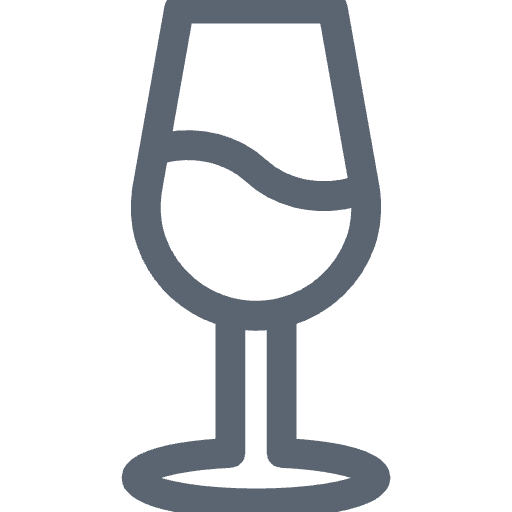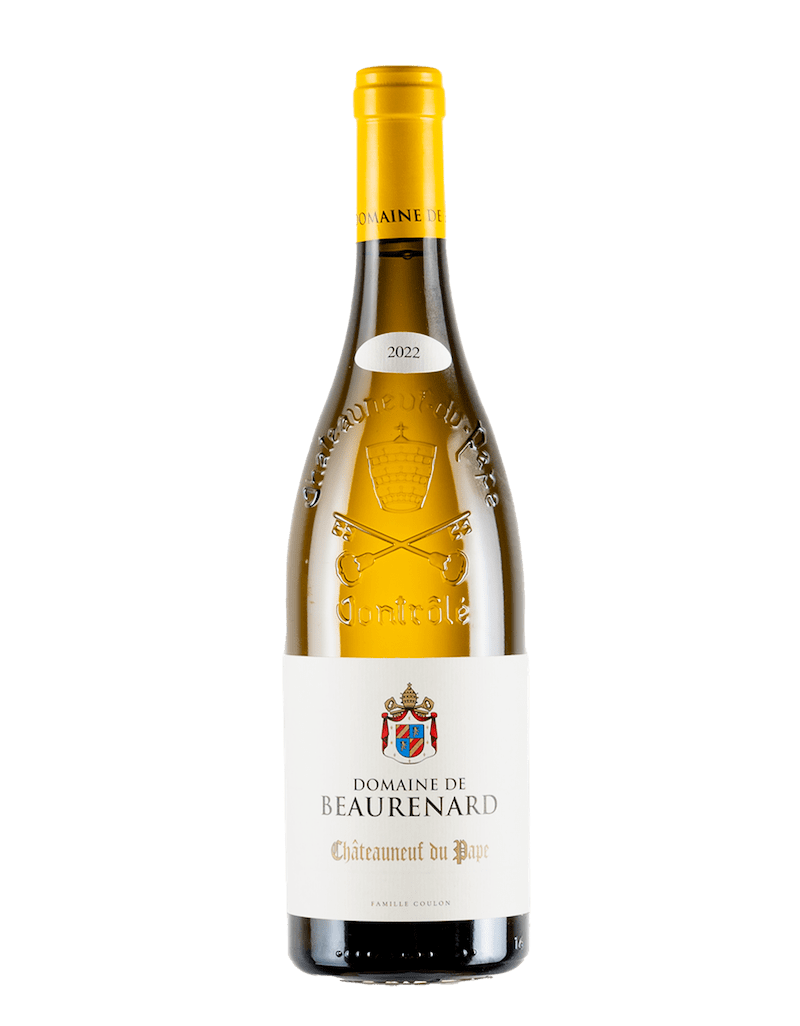GENERAL INFORMATION ABOUT WHITE WINE
White wine is primarily made from light-colored grape varieties, whose berry color (one grape consists of many berries) can vary from deep green to golden yellow. Famous examples include Riesling, Chardonnay, and Sauvignon Blanc, with each variety producing very different wines with its own individual characteristics. Unlike red wine, white wine is produced by fermenting only the pure juice (must) and separating it from the mash (grape skins, pulp, and seeds). Furthermore, the residual sugar content plays a much greater role in white wine and significantly influences the style of the wine.
WHITE WINE PRODUCTION
AFTER THE HARVEST
Once they arrive at the winery, the light-colored grapes are usually pressed immediately. A distinction is made here between whole-bunch pressing and must pressing. In the latter case, the grapes are destemmed, i.e., freed from the stalks, whereas whole-bunch pressing means pressing the entire grape material. The stalks form small channels that allow the must to flow more quickly during the pressing process. As a result, the must absorbs fewer suspended solids and is particularly clear and pure. This technique is primarily used in sparkling wine production or when the winemaker wants to achieve a particularly fresh style. However, must fermentation also allows for certain variations in intensity and duration. Longer pressing ensures longer contact with the must and thus more intensive extraction of color and flavor.
FERMENTATION
After pressing is complete, fermentation begins, the process in which yeast converts sugar into alcohol and carbon dioxide. The winemaker must decide in which container the fermentation will take place. The majority of white wines are fermented in stainless steel containers or wooden barrels, but containers made of concrete, clay, or plastic are sometimes used. Each material has a specific effect on fermentation and on the wine, with the decisive factors being oxygen and temperature. A cool fermentation in stainless steel with the exclusion of oxygen promotes cool and fresh fruit aromas. Fermentation in wooden barrels, on the other hand, does not allow precise temperature control and (depending on the size and age) ensures minimal oxygen exchange, which can round out the aromas.
THE EXPANSION
Once fermentation is complete, the wine's aging process begins. Here, too, the influence of oxygen or micro-oxidation plays a crucial role. Furthermore, the yeast cells have died and collect at the bottom of the fermentation vessel. The winemaker can separate the wine from the so-called "lees" or leave it on the lees (sur lie). During this type of aging, which lasts several months, the yeasts slowly decompose (autolysis), imparting additional aromas and a perceptible fullness to the mouth, often described as creaminess. Aging on the lees is often accompanied by the use of toasted, i.e., charred, oak barrels such as barriques, which can contribute aromas of smoke, toast, caramel, and honey.
WHITE WINE CHARACTER & TASTE
Not every grape variety is equally suited to every aging method. Chardonnay and Viognier produce excellent, voluminous white wines from oak barrels, while Sauvignon Blanc often impresses with a cool fruitiness from steel tanks. Of course, the transitions are fluid, and the individual style of the winemaker is decisive.
Unlike red wine, sweetness plays a key role in white wine. Traditional sweet wines from Alsace, Germany, and Austria were originally produced solely to compensate for a lack of ripeness due to low temperatures. In the southern wine-growing countries of France, Italy, and Spain, white wines were and still are typically bone dry. Dry wines have also been increasingly produced in the north for some time, but noble sweet wines such as Beerenauslese, Trockenbeerenauslese, or Vendanges Tardives still represent a very special category. Extremely high sugar content (>40 g/L) and pronounced acidity create a unique firework for the senses and are ideal as an accompaniment to spicy cheeses, pâtés, or desserts.
FAQ ABOUT WHITE WINE
Which white wine to use for cooking: dry or sweet?
Dry white wine is most commonly used for cooking because it has a more balanced acidity and less residual sugar. However, the choice of wine depends on the dish being prepared.
How many calories does dry white wine have?
Dry white wine contains on average about 70-90 calories per 100 ml.
How long does white wine last unopened?
An unopened white wine can last for about 1 to 3 years or even longer, depending on its quality and storage conditions.
How long does open white wine last?
Once opened, white wine will usually keep in the refrigerator for about 3-5 days, although the quality may deteriorate over time.
Which white wine is good for cooking?
Dry white wines like Sauvignon Blanc, Riesling, or Chardonnay are ideal for cooking with most dishes. The right choice depends largely on the specific dish. Generally speaking, the more fat-rich the wine, the better the acidity.
What drinking temperature for white wine?
The recommended drinking temperature for white wine is typically between 8°C and 12°C. Lighter white wines can be served cooler, while stronger varieties should be enjoyed slightly warmer.
Which white wine to use for cooking salmon?
A dry white wine with a certain acidity, such as a Sauvignon Blanc or a dry Riesling, is good for cooking salmon.
Which white wine to use for cooking fish?
Dry white wines with good acidity, such as Sauvignon Blanc or Riesling, are suitable for preparing fish dishes.
Which white wine to use for cooking pasta?
Dry white wines such as Chardonnay or Sauvignon Blanc can be used with pasta dishes, depending on the desired flavor of the dish.

 Burgenland
Burgenland  Welschriesling, dry
Welschriesling, dry fruity & mineral
fruity & mineral

 Moselle
Moselle  Riesling, sweet
Riesling, sweet fine & radiant
fine & radiant

 Moselle
Moselle  Riesling, sweet
Riesling, sweet fruity sweet & fresh
fruity sweet & fresh

 Rhône
Rhône  Cuvée, dry
Cuvée, dry full-bodied & elegant
full-bodied & elegant

 Burgenland
Burgenland  Chardonnay, dry
Chardonnay, dry mineral & complex
mineral & complex

 Rheinhessen
Rheinhessen  Pinot Blanc, dry
Pinot Blanc, dry creamy & balanced
creamy & balanced

 Loire
Loire  Sauvignon Blanc, dry
Sauvignon Blanc, dry concentrated & rocky
concentrated & rocky

 Burgundy
Burgundy  Chardonnay, dry
Chardonnay, dry elegant & profound
elegant & profound

 Rheingau
Rheingau  Riesling, dry
Riesling, dry elegant & complex
elegant & complex

 Rheingau
Rheingau  Riesling, dry
Riesling, dry mineral, cool, light
mineral, cool, light

 Loire
Loire  Sauvignon Blanc, dry
Sauvignon Blanc, dry vegetable & silky
vegetable & silky

 Sicily
Sicily  Catarratto, dry
Catarratto, dry herbaceous & stony
herbaceous & stony

 Rheinhessen
Rheinhessen  Riesling, dry
Riesling, dry mineral & elegant
mineral & elegant

 Rheinhessen
Rheinhessen  Riesling, dry
Riesling, dry complex & melting
complex & melting

 Rheinhessen
Rheinhessen  Riesling, dry
Riesling, dry fruity & aromatic
fruity & aromatic

 Moselle
Moselle  Riesling, dry
Riesling, dry complex & focused
complex & focused

 Moselle
Moselle  Riesling, sweet
Riesling, sweet fruity & juicy
fruity & juicy

 Rheinhessen
Rheinhessen  Riesling, dry
Riesling, dry mineral & elegant
mineral & elegant

 Burgundy
Burgundy  Chardonnay, dry
Chardonnay, dry mineral & complex
mineral & complex

 Moselle
Moselle  Riesling, dry
Riesling, dry fresh & mineral
fresh & mineral

 Rheinhessen
Rheinhessen  Riesling, dry
Riesling, dry cool and juicy
cool and juicy

 Sicily
Sicily  Grillo, dry
Grillo, dry fruity & floral
fruity & floral

 Loire
Loire  Sauvignon Blanc, dry
Sauvignon Blanc, dry intense & rocky
intense & rocky

 Moselle
Moselle  Riesling, dry
Riesling, dry complex & focused
complex & focused

























